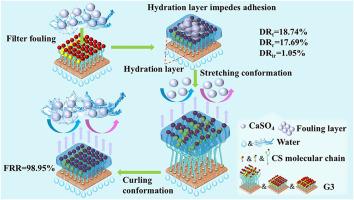Preparation of pH-responsive PVDF membrane and investigation of the synergistic anti-fouling and self-cleaning mechanism via “hydration layer & steric hindrance” and “acid washing-alkaline washing”
IF 4.5
2区 化学
Q2 POLYMER SCIENCE
引用次数: 0
Abstract
In this study, the polyvinylidene fluoride (PVDF) membrane with hydrophilicity and pH-responsiveness was prepared by grafting chitosan (CS). The pH-responsiveness refers to a property of the membrane to undergo controlled and reversible changes in its structure, physical, and chemical properties in response to variations in the environmental pH. For comparison, polyethyleneglycol 400 (PEG400), which is hydrophilic but not pH-responsive, was introduced onto the membrane surface as a control. The differences in parameters were compared among the modified membranes, including surface charge, hydration layer properties and anti-fouling performance against calcium sulfate (CaSO4). The effect of the conformation change in CS on foulant removal was investigated in the pH range of 2–12. The results showed that the thickest hydration layer (205.43 nm) was formed on the surface of G3, which effectively inhibits the adhesion of foulants to the membrane surface. In addition, G3 exhibited superior anti-fouling and self-cleaning performance during the “acid washing (pH = 2)-alkaline washing (pH = 12)” process, as evidenced by the flux recovery rate of 98.95 %, the total flux decline rate of 18.74 % and the irreversible fouling rate of only 1.05 %. Based on differences in CaSO4 agglomeration behavior and removal efficiency among the membranes, the synergistic mechanism of anti-fouling and self-cleaning based on “hydration layer & steric hindrance” and “acid washing-alkaline washing” was proposed. This study laid the foundation for the preparation of membranes with high anti-fouling performance using CaSO4 as a model foulant. The proposal of the synergistic mechanism can provide new insights into the efficient removal of foulants.


ph响应型PVDF膜的制备及“水合层-位阻”和“酸洗-碱洗”协同防污自洁机理研究
本研究采用壳聚糖(CS)接枝法制备了具有亲水性和ph响应性的聚偏氟乙烯(PVDF)膜。ph响应性是指膜的一种特性,即随着环境ph的变化,膜的结构、物理和化学性质会发生可控和可逆的变化。为了进行比较,将亲水但不具有ph响应性的聚乙二醇400 (PEG400)引入膜表面作为对照。比较了不同改性膜的表面电荷、水合层性能和对硫酸钙(CaSO4)的抗污性能等参数的差异。在2 ~ 12的pH范围内,研究了CS的构象变化对污染物去除的影响。结果表明,G3表面形成了最厚的水化层(205.43 nm),有效抑制了污染物对膜表面的粘附;在“酸洗(pH=2)-碱洗(pH=12)”过程中,G3表现出优异的防污自洁性能,通量回收率为98.95%,总通量下降率为18.74%,不可逆结垢率仅为1.05%。基于不同膜间CaSO4团聚行为和去除效率的差异,提出了基于“水合层&位阻”和“酸洗-碱洗”的抗污自洁协同机理。本研究为以CaSO4为模型污染物制备高抗污性能膜奠定了基础。该协同机理的提出为高效除污提供了新的思路。
本文章由计算机程序翻译,如有差异,请以英文原文为准。
求助全文
约1分钟内获得全文
求助全文
来源期刊

Polymer
化学-高分子科学
CiteScore
7.90
自引率
8.70%
发文量
959
审稿时长
32 days
期刊介绍:
Polymer is an interdisciplinary journal dedicated to publishing innovative and significant advances in Polymer Physics, Chemistry and Technology. We welcome submissions on polymer hybrids, nanocomposites, characterisation and self-assembly. Polymer also publishes work on the technological application of polymers in energy and optoelectronics.
The main scope is covered but not limited to the following core areas:
Polymer Materials
Nanocomposites and hybrid nanomaterials
Polymer blends, films, fibres, networks and porous materials
Physical Characterization
Characterisation, modelling and simulation* of molecular and materials properties in bulk, solution, and thin films
Polymer Engineering
Advanced multiscale processing methods
Polymer Synthesis, Modification and Self-assembly
Including designer polymer architectures, mechanisms and kinetics, and supramolecular polymerization
Technological Applications
Polymers for energy generation and storage
Polymer membranes for separation technology
Polymers for opto- and microelectronics.
 求助内容:
求助内容: 应助结果提醒方式:
应助结果提醒方式:


